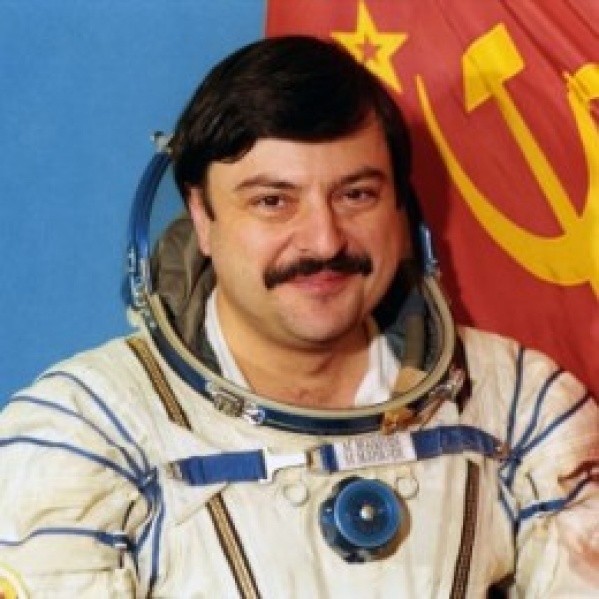Musa Manarov
Russian - (RFSA)
Retired
Date of Birth: March 22, 1951
Age: 74
Musa Khiramanovich Manarov (Russian: Муса Хираманович Манаров; born March 22, 1951 in Baku, Azerbaijan SSR) is a former cosmonaut who spent 541 days in space. From December 21, 1987 to December 21, 1988 he flew as flight engineer on Soyuz TM-4. The flight duration was 365 days 22 hours 38 minutes. From December 2, 1990 to May 26, 1991 he flew again as a flight engineer on Soyuz TM-11. The duration was 175 days 1 hour 50 minutes,[2] the longest continuous time spent in space by anyone at that time. During his 176-day stay, Manarov observed the Earth and worked in space manufacturing. He also performed 20 hours of spacewalks.
Soyuz-U2 | Soyuz TM-4
Soviet Space Program | RussiaBaikonur Cosmodrome, Republic of Kazakhstan
Dec. 21, 1987, 11:18 a.m.
Status: Success
Mission:
Soyuz TM-4 was the fourth mission to Mir space station. The mission began on December 21, 1987, 11:18:03 UTC, launching Commander Vladimir Titov, Flight Engineer Musa Manarov and Research Cosmonaut Anatoli Levchenko into orbit. They docked with Mir two days later. During their stay there, crew carried out over 2000 various experiments, performed two EVAs. They were visited by Soyuz TM-5 and Soyuz TM-6 crews. Vladimir Levchenko spent only a week on the station, while other two members of the crew stayed for a long duration mission. They returned on a Soyuz TM-6 spacecraft, landing safely back on Earth on December 21, 1988, 09:57:00 UTC.
Low Earth OrbitSoyuz-U2 | Soyuz TM-6
Soviet Space Program | RussiaBaikonur Cosmodrome, Republic of Kazakhstan
Aug. 29, 1988, 4:23 a.m.
Status: Success
Mission:
Soyuz TM-6 was the sixth mission to Mir space station. The mission began on June 7, 1988, 14:03:13 UTC, launching Commander Vladimir Lyakhov, Flight Engineer/Research Doctor Valeri Polyakov and Research Cosmonaut Abdul Mohmand, the first Afghan cosmonaut, into orbit. They docked with Mir two days later, meeting with the long-duration resident crew. During their 7-day stay there, cosmonauts performed Earth observation and other tasks. They returned on a Soyuz TM-5 spacecraft, landing safely back on Earth on September 7, 1988, 00:49:38 UTC.
Low Earth OrbitSoyuz-U2 | Soyuz TM-11
Soviet Space Program | RussiaBaikonur Cosmodrome, Republic of Kazakhstan
Dec. 2, 1990, 8:13 a.m.
Status: Success
Mission:
Soyuz TM-11 was the 11th mission and the eighth long-duration expedition to Mir space station. The mission began on December 2, 1990, 08:13:32 UTC, launching Commander Viktor Afanasyev, Flight Engineer Musa Manarov and Research Cosmonaut Toyohiro Akiyama, the first space tourist, into orbit. They docked with Mir two days later. During their stay there, cosmonauts performed EVAs, various station repair and maintenance tasks, and carried out scientific experiments in biology, geophysics, space technology, astronomy etc. They were visited by several Progress resupply spacecrafts, and welcomed aboard the ninth long-duration expedition crew, which arrived in Soyuz TM-12 vehicle. Toyohiro Akiyama returned on December 10, 1990, in Soyuz TM-10 spacecraft, while the mission itself concluded with a safe landing back on Earth on May 26, 1991, 10:04:13 UTC.
Low Earth OrbitThe Roscosmos State Corporation for Space Activities, commonly known as Roscosmos, is the governmental body responsible for the space science program of the Russian Federation and general aerospace research. Soyuz has many launch locations the Russian sites are Baikonur, Plesetsk and Vostochny however Ariane also purchases the vehicle and launches it from French Guiana.
Soyuz 2.1a
Obzor-R No.1
43/4 (43R) - Plesetsk Cosmodrome, Russian FederationNote: Assignment of payloads to this launch is uncertain. The Russian Obzor-R satellite is a planned X-band radar earth observation satellite desi…
LVM-3 (GSLV Mk III)
BlueBird Block 2 #1
Satish Dhawan Space Centre Second Launch Pad - Satish Dhawan Space Centre, IndiaAST SpaceMobile’s Block 2 BlueBird satellites are designed to deliver up to 10 times the bandwidth capacity of the BlueBird Block 1 satellites, requi…
Long March 12A
Demo Flight
Long March 12A Pad - Jiuquan Satellite Launch Center, People's Republic of ChinaFirst test launch of CASC/SAST’s Long March 12A rocket, with a dummy payload. The rocket’s 1st stage attempted to land on a landing pad about 300 km …
HANBIT-Nano
Spaceward
HANBIT Pad - Alcântara Space Center, Federative Republic of BrazilMaiden orbital launch attempt for the South Korean start-up Innospace and its HANBIT-Nano small launch vehicle. Onboard this flight are five small sa…
H3-22
Michibiki 5 (QZS-5)
Yoshinobu Launch Complex LP-2 - Tanegashima Space Center, JapanQZSS (Quasi Zenith Satellite System) is a Japanese satellite navigation system operating from inclined, elliptical geosynchronous orbits to achieve o…



